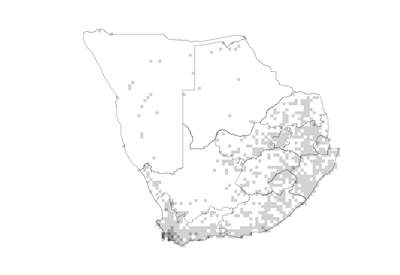 Species distribution and density. Darker squares represent higher density of members of this family. |
Introduction
(including Cyphiaceae)Lobelia family
A widespread, medium-sized family of mostly perennial herbs with irregular flowers. Sometimes included in Campanulaceae but has irregular flowers and connate anthers as opposed to regular flowers and free anthers as in Campanulaceae.
Distribution
Members of this family are mostly found in the tropics and the southern hemisphere. In southern Africa it is widespread, with the highest diversity in the Western Cape; uncommon in the dry interior.
Number of genera in the world
ca. 30
Number of species in the world
ca. 1 260
Number of genera in the Flora of southern Africa region
6
Number of species in the Flora of southern Africa region
187
Growth forms
Mostly herbs, also thick-stemmed and sparsely branched (pachycaul) giant herbs (e.g. *Lobelia deckenii) and lianas, sometimes with twining stems (Cyphia).
Habitats
Found in a variety of habitats but often in moist places and forest.
Flagship species
Monopsis decipiens (butterfly lobelia; skoenlapperplant [A]; isidala somkhuhlane [Z]) is an erect herb found in seasonally wet places in the eastern parts of southern Africa. The flowers are blue and purple with yellow markings on the lower lip and are solitary on a slender pedicel. This species is used in traditional medicine to treat colds, skin diseases and rheumatism.
Significance of the family
Latex from Lobelia species has been used medicinally to treat respiratory problems; *L. inflata is a source of lobeline, used in anti-smoking therapy. Some Lobelia species are used in traditional medicine for eardrops and to treat colds; also used for magical purposes. The roots of certain Cyphia species are edible, eaten raw or roasted; they are also used in traditional medicine as an emetic. Some Lobelia species are popular garden plants, especially in window boxes and hanging baskets and some are browsed by game and livestock. Many members of the family are poisonous.
Diagnostic characters
Plants usually contain milky latex . Leaves simple, mostly alternate without stipules . Flowers irregular (often 2-lipped) , usually resupinate. Flowering parts usually pentamerous, united or rarely free. Anthers connate into a tube � or free (Cyphia). Ovary inferior �. Fruit a dehiscent capsule often crowned by persistent calyx lobes .
Did you know?
The family is named after Matthias de L'Obel [1538-1616], a Flemish botanist and physician to King James I.